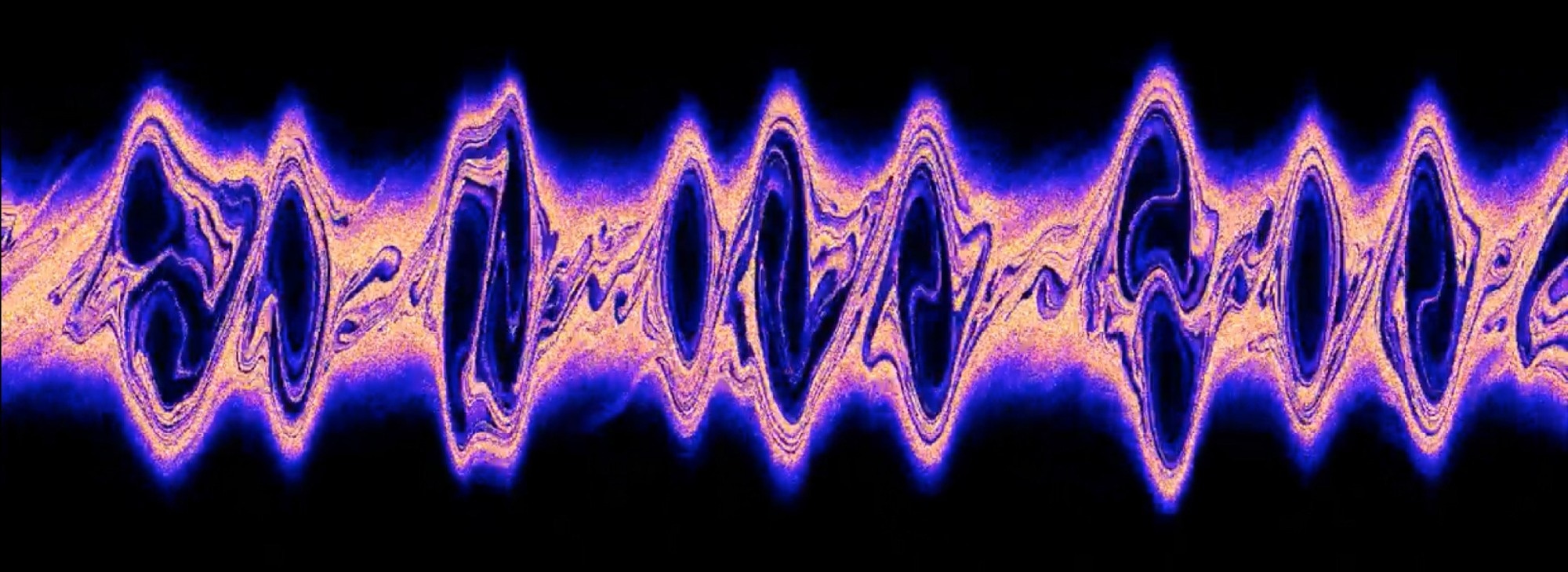Researchers at the Leibniz Institute for Astrophysics Potsdam (AIP) have identified a novel plasma instability that might fundamentally alter the understanding of cosmic ray origins and their dynamic effects on galaxies.
 Simulation of cosmic rays counter-streaming against a background plasma and exciting a plasma instability. Shown is the distribution of background particles responding to the streaming cosmic rays in phase space, which is spanned by particle position (horizontal axis) and velocity (vertical axis). The colours visualize the number density and the phase space holes are manifestations of the highly dynamical nature of the instability that dissipates ordered into random motions. Image Credit: Shalaby/AIP
Simulation of cosmic rays counter-streaming against a background plasma and exciting a plasma instability. Shown is the distribution of background particles responding to the streaming cosmic rays in phase space, which is spanned by particle position (horizontal axis) and velocity (vertical axis). The colours visualize the number density and the phase space holes are manifestations of the highly dynamical nature of the instability that dissipates ordered into random motions. Image Credit: Shalaby/AIP
Victor Hess received the Nobel Prize in physics for discovering cosmic rays at the turn of the 20th century. He discovered that the radioactivity of the ground does not ionize the Earth's atmosphere during high-altitude balloon flights. Instead, he verified that extraterrestrials were the source of ionization.
It was later discovered that cosmic “rays” are not radiation but charged particles from outer space traveling at almost the speed of light. But the term “cosmic rays” survived these discoveries.
The main author of the new study, Dr. Mohamad Shalaby, together with his colleagues at AIP, used numerical simulations to track the paths of several cosmic ray particles and examine their interactions with the surrounding plasma, which is made up of protons and electrons.
The novel feature the researchers observed when seeing cosmic rays traveling from one side of the simulation to the other is that it stimulates electromagnetic waves in the background plasma. The cosmic rays are subject to a push from these waves that modifies their spiraling trajectories.
Above all, this novel phenomenon can be best explained if cosmic rays serve as the support for a collective electromagnetic wave rather than as individual particles. An energy transfer occurs when this wave interacts with the underlying waves in the background, causing them to become significantly magnified.
This insight allows us to consider cosmic rays as behaving like radiation and not individual particles in this context, just as it has been originally believed by Victor Hess. This progress only came about by considering smaller scales that have previously been overlooked and that question the use of effective hydrodynamic theories when studying plasma processes.
Christoph Pfrommer, Professor and Head, Cosmology and High-Energy Astrophysics, Leibniz Institute for Astrophysics Potsdam
The behavior of individual water molecules coming together to produce a wave that breaks at the shore is an excellent way to describe this behavior.
This progress only came about by considering smaller scales that have previously been overlooked and that question the use of effective hydrodynamic theories when studying plasma processes.
Dr. Mohamad Shalaby, Postdoctoral Researcher, Leibniz Institute for Astrophysics Potsdam
This recently found plasma instability has several uses, one of which is providing a first explanation for the process by which electrons from the hot interstellar plasma could be pushed to high energy at supernova remnants.
Shalaby added, “This newly found plasma instability represents a significant leap in our understanding of the acceleration process and finally explains why these supernova remnants shine in the radio and gamma rays.”
Furthermore, this ground-breaking discovery opens the door to a better understanding of the fundamental mechanisms of cosmic ray transport in galaxies, which has long been a puzzle in understanding the processes that form galaxies during their cosmic evolution.
Journal Reference:
Shalaby, M., et. al. (2023) Deciphering the physical basis of the intermediate-scale instability. Journal of Plasma Physics. doi:10.1017/S0022377823001289